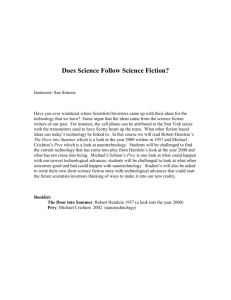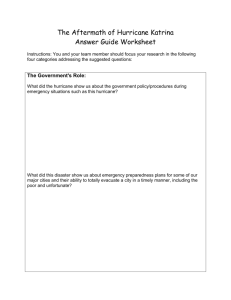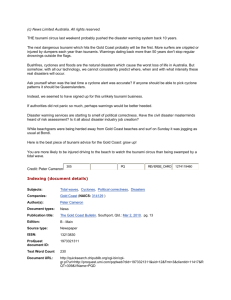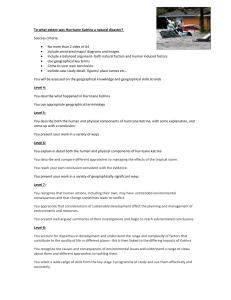When Disasters Strike
advertisement
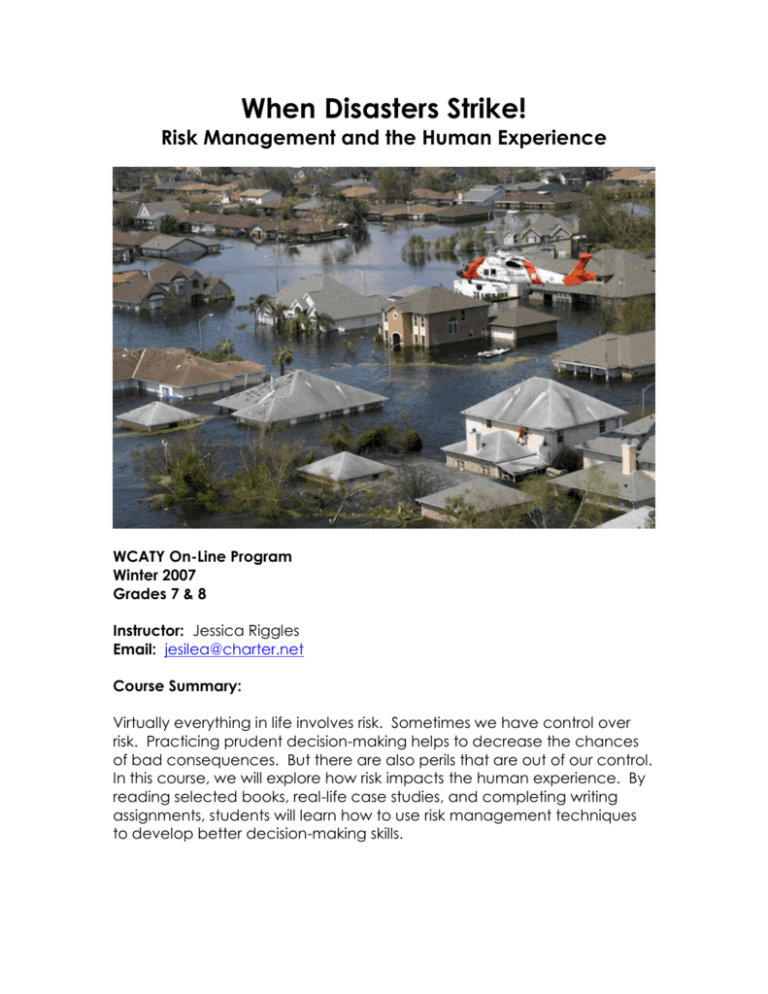
When Disasters Strike! Risk Management and the Human Experience WCATY On-Line Program Winter 2007 Grades 7 & 8 Instructor: Jessica Riggles Email: jesilea@charter.net Course Summary: Virtually everything in life involves risk. Sometimes we have control over risk. Practicing prudent decision-making helps to decrease the chances of bad consequences. But there are also perils that are out of our control. In this course, we will explore how risk impacts the human experience. By reading selected books, real-life case studies, and completing writing assignments, students will learn how to use risk management techniques to develop better decision-making skills. Required Reading: Life of Pi by Yann Martel The Mosquito Coast by Paul Theroux Various case studies and articles One of the following books of the student’s choosing: Saving Fish from Drowning by Amy Tan The Poisonwood Bible by Barbara Kingsolver My Sister’s Keeper by Jodi Piccoult Mayada: Daughter of Iraq by Jean Sasson Optional Videos: Students may choose one optional video to replace one of the case studies assigned. The student will complete the risk management chart on the video subject and write a well-formed paragraph summary. Johnstown Flood, Directed by Charles Guggenheim (1989) (Available on Google Video for $3.75) Is Walmart Good for America? Wall Street Tsunami: The AftermathThe Corporation An Inconvenient Truth Hotel Rwanda Thank You for Smoking Required Assignments Summary: All students will read each of the required books and non-fiction articles assigned. Students will write a weekly reading response in their journal. Reading responses will consist of three paragraphs: 1) Reflection of the plot and characters in the material. 2) Contemplation of the literary techniques used in the material. 3) Discussion of the risk management techniques used by the characters or what techniques the character could have used better. Participation is mandatory, both in the online discussions and at the face-to-face meetings. All written responses need to be thoughtful and grammatically correct. Each student will be expected to contribute to the class discussion by offering a written response to three of the student postings each week. Students will write one formal five-paragraph essay. Students will participate in two group research projects. The first is a comparative project looking at Hurricane Katrina and the 2004 Asian Tsunami. The group will research their topic, keeping in mind the risk management techniques. All students will write an individual five-paragraph essay or a fictional short story. The group members will work together to proof-read each other’s paper. The second group research project will be a comparative project from one of the following topics: The Johnstown Flood, 1889 The Grand Forks Flood, 1997 The San Francisco Earthquake, 1906 The Northridge Earthquake, 1994 The Destruction of Pompeii, 79 The Mount St Helen’s Eruption, 1980 The London Fire, 1666 The Oakland Fire, 1991 The Donner Party, 1846 Uruguayan Rugby Team, 1972 The Hindenburg Disaster, 1937 The Crash of PanAm 103, 1988 The Titanic, 1912 Le Joola Shipwreck, Gambia, 2002 The Columbine School Shooting, 1999 Weston High School Shooting, 2006 London Blitz, WWII London Bombing, 2005 California Mud Slides, 1998 Philippine Mud Slides, 2006 The group will prepare a 15-minute presentation using visual aids to teach the class about their topic. They will then lead a class discussion using the risk management chart exploring the techniques used and what could have been used better. Weekly Course Outline Week 1: Focus on the role of the individual Reading: Life of Pi, chapters 1 through 26 (including the author’s introduction.) Write journal reading response. Thought provoker 1: Do people deserve what they get? Thought Provoker 2: What role does suffering play in the human experience? In chapter one of Life of Pi, Pi says, “When you’ve suffered a great deal in life, each additional pain is both unbearable and trifling.” How is this both true and false? Task: Read and familiarize yourself with the Risk Management handout and risk management chart. Face-to- Face 1: Through hands on learning, analyzing scenarios, and team work, students will: Meet and greet. Review online community rules and procedures Review work expectations and rubrics Review the Hamburger format Review risk management chart Review literary techniques Week 2: Focus on the role of the individual Reading: Life of Pi, chapters 27 through 61. Write journal reading response.Thought Provoker 1: What is the relationship like between Pi and Richard Parker? Thought Provoker 2: Would you stand up for something even if it meant that your family would pay for it in the long run? Task: Read case study: “The Aircraft Brake Scandal.” Fill out risk management chart. Week 3: Focus on the role of the individual Reading: Life of Pi, chapters 62 through the end. Write journal reading response. Thought Provoker 1: What is the difference between human and animal decision making? Thought Provoker 2: How does company marketing and commercials affect our decisions? Week 4: Focus on the role of society Reading: Begin the Mosquito Coast, chapters 1 – 10. Write journal reading response. Thought Provoker 1: Discuss your thoughts on Life of Pi. What did you like? What did you not like? Which do you feel was the better story? How do you feel about the ways Pi dealt with risk? Support your opinions with examples or quotes from the text. Thought Provoker 2: In The Mosquito Coast, is Allie Fox insane or a genius? What are your thoughts on his philosophies and actions? Give examples from the text to support your opinions. Group Project: Find at least ten websites about Hurricane Katrina. Place yourself in four of the following roles. Use the risk management chart to determine what risk techniques were used and what techniques could have been used better in each role. This means that you will have four different charts at the end of the assignment. Finally, the group will write a well-formed paragraph that summarizes what you found. FEMA official Local government official Charity Organizer Townsperson Insurance company World Aid Organizations Celebrities **Test: Review of novel and case studies. Week 5: Focus on the role of society Reading: The Mosquito Coast, chapters 11 – 20. Write journal reading response. Thought Provoker 1: What role did race or culture play in the Hurricane Katrina and the 2004 Asian Tsunami disasters? Is that normal? Thought Provoker 2: In The Mosquito Coast, what is the relationship like between Allie and Charlie? Describe some a situation where Allie puts Charlie at risk. Why does he do this and how does Charlie handle it? Group Project: Find at least 10 websites about the 2004 Asian Tsunami. Placing yourself in four of the following roles, use the risk management chart to determine what risk techniques were used and what techniques could have been used better. This means that you will have four different charts at the end of the assignment. Finally, write a well-formed paragraph that summarizes what you found. Government official Charity organizer Townsperson/villager Insurance company World Aid Organizations Celebrities Project: Write a rough five-paragraph essay (format will be presented in the online community) which compares and contrasts Hurricane Katrina and the 2004 Asian Tsunami. Post this rough draft in your group. Finally, proofread the other group members’ papers. Face-to- Face 2: Through hands on learning, analyzing scenarios, and team work, students will: Review paper format and how to properly cite your work Role playing using research from both Tsunami and Katrina Review risk management themes Review case studies Choose topic for project Go over PowerPoint etiquette Week 6: Focus on the role of society Reading: The Mosquito Coast, chapter 21 to the end. Write journal reading response. Thought Provoker 1: In what ways does our society help or support individuals in need? Is this the obligation of society? Why or why not? Thought Provoker 2: Using what you learned from your research on Hurricane Katrina and the 2004 Asian Tsunami, how do you think people deal with grief after a disaster? Are these coping mechanisms positive or negative? Thought Provoker 3: Reflecting on The Mosquito Coast, what risks did the family take and how did they deal with them? Was it worth it? Project: Polish paper and turn it in. Also, begin researching your topic and work on outline for your group presentation. WEEK 7: The role of the company Reading: Begin book of choice from reading list. Write journal reading response. Thought Provoker 1: What is the price of a human life? Thought Provoker 2: Should companies be put out of business when they are found to be negligent? Think of all of the consequences. Task: Review case study: “The Ford Pinto” and fill out chart. Group Project: Research your topic and work on outline for your group presentation. Week 8: The role of the company Reading: Continue book of choice. Write journal reading response. Thought Provoker 1: What role do companies have when it comes to social issues? Task: “Uncommon Decency: Pacific Bell Responds to AIDS” Project: Continue research and rough draft of the Group Presentation. Students are to continue to work as a group, editing and writing for their presentation. **Test: Review of novel and case studies. Week 9: The role of the company Reading: Finish book of choice. Write journal reading response. Task: “H.B. Fuller in Honduras: Street Children and Substance Abuse “Merck & Co. Inc.” and “Plasma International.” Work with the risk management chart. Thought Provoker 1: What responsibility do we have to care for those who are less fortunate? Thought Provoker 2: Should a company be responsible for its product, even if it is being used in a way for which it was not intended? Project: Finish project and prepare to present it. Face-to- Face 3: Through hands-on learning, analyzing scenarios, and team work, students will: Present group presentations. Review of risk management concepts Discussion: Applying risk management in your life


